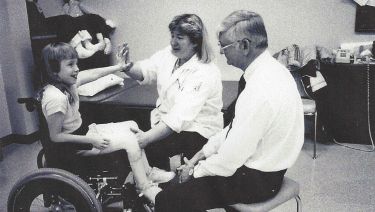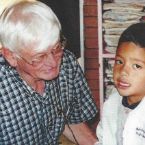By: Olson Huff, MD, FAAP
In 1962, during my senior year in medical school, I worked at the evening clinic at Louisville General Hospital. By 6:00 pm the waiting room was full, and it was not hard, even for a medical school student like me at the time, to diagnose the many
measles cases that awaited treatment as coughs filled the air and many children presented with the distinct rash and red eyes that are common with measles patients.
The majority of cases we were seeing were measles cases. Measles is one of the most communicable diseases you can come across. The fevers associated with those patients were atrociously high, and the medication we used to reduce those fevers came with unfortunate side effects. The only thing we could do was treat the symptoms of measles; we could not help fight the measles infection itself at all.
 I vividly remember how sick the children were, and I also remember the worried expressions that those parents had. They felt worried and helpless. They had a right to feel worried, because some of these children died.
I can tell you that the doctors were just as worried as the parents. We could not do much. We had no tools to fight or prevent the disease.
I vividly remember how sick the children were, and I also remember the worried expressions that those parents had. They felt worried and helpless. They had a right to feel worried, because some of these children died.
I can tell you that the doctors were just as worried as the parents. We could not do much. We had no tools to fight or prevent the disease.
I have to admit that I was glad to rotate off the night clinic at Louisville General Hospital, because then I didn't have to face all those desperately sick children, and their worried parents.
It wasn't long after I rotated off the ER that we heard that a
measles vaccine had been developed. We were extremely happy, because we knew we would soon have something that would stop these children from getting the measles.
The vaccine was distributed by the manufacturer very quickly. In the last two months of my internship, I do not remember seeing a single case of measles! At the time I was working with a worldwide patient population, because I was then in Texas at the U.S. Air Force Hospital, Wilford Hall.
Of course, the measles vaccine was not the only immunization to be introduced during my career. But for me, it was the most memorable. It was tied to my early years as a pediatrician, and it was so incredibly successful. For those of us who lived those days, and saw the specter of death in far too many children, we continue to be grateful for the amazing role vaccines have had in protecting our children.
About Dr. Huff:
 Olson Huff, MD FAAP has practiced pediatrics in North Carolina all of his professional career. He is a veteran of the USAF, and served as a flight surgeon in Southeast Asia and at Pease Air Force Base in New Hampshire, during the Vietnam War. In 1987, Dr. Huff established the child development program at Thomas Hospital in Asheville, and under his leadership in 1994, Mission Children's Hospital, the only children's hospital in Western North Carolina, was formed. Dr. Huff has received many professional accolades, including the American Academy of Pediatrics special recognition award for advancing dental care to low income children. Dr. Huff lives in Black Mountain with his wife, Marylyn. They have three sons and four growing grandchildren.
Olson Huff, MD FAAP has practiced pediatrics in North Carolina all of his professional career. He is a veteran of the USAF, and served as a flight surgeon in Southeast Asia and at Pease Air Force Base in New Hampshire, during the Vietnam War. In 1987, Dr. Huff established the child development program at Thomas Hospital in Asheville, and under his leadership in 1994, Mission Children's Hospital, the only children's hospital in Western North Carolina, was formed. Dr. Huff has received many professional accolades, including the American Academy of Pediatrics special recognition award for advancing dental care to low income children. Dr. Huff lives in Black Mountain with his wife, Marylyn. They have three sons and four growing grandchildren.
Medicine Before Vaccines
This article is part of a series of first-person accounts from senior pediatricians about what it was like to practice pediatric medicine before vaccines for diseases like meningitis, measles and the flu were available. These articles are being published in recognition of National Immunization Awareness Month, which is held in August every year.